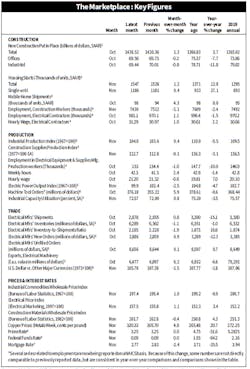Electrical Marketing's Leading Indicators - December 18, 2020
November building permits continue surge. Privately-owned housing units authorized by building permits in November were at a seasonally adjusted annual rate of 1,639,000, +6.2% above the revised October rate of 1,544,000 and +8.5% above the Nov. 2019 rate of 1,510,000. Single-family authorizations in November were at a rate of 1,143,000, +1.3% above the revised October figure of 1,128,000. Authorizations of units in buildings with five units or more were at a rate of 441,000 in November.
AIA says architects’ confidence in future project activity fades in November. Architecture firm billing activity is contracting once again after two months of a slowing decline, according to the American Institute of Architects (AIA), Washington, DC. The pace of decline during November accelerated from October, posting an Architecture Billings Index (ABI) score of 46.3 points from 47.5 points (any score below 50 indicates a decline in firm billings). “In previous design cycles, we typically haven’t seen a straight line back to growth after a downturn hits,” said AIA Chief Economist Kermit Baker, in the press release. “The path to recovery is shaping up to be bumpier than we hoped for. While there are pockets of optimism in design services demand, the overall construction landscape remains depressed.”
Leading Indicators increase again in October. The Conference Board’s Leading Economic Index (LEI) for the U.S. increased +0.7% in October to 108.2 (2016 = 100), following a +0.7% increase in September and a +1.6% increase in August. “The U.S. LEI rose again in October, with widespread improvements despite weakness from housing permits and consumers’ outlook on economic conditions,” said Ataman Ozyildirim, senior director of economic research at The Conference Board. “However, the leading index has been decelerating in recent months, which suggests growth will moderate significantly in the final months of 2020, slowing down from the unusually rapid pace in Q3. Furthermore, downside risks to growth from a second wave of COVID-19 and high unemployment persist. While the Conference Board projects the US economy will expand in Q4, the pace of growth is unlikely to exceed +2.2% (annual rate).”



